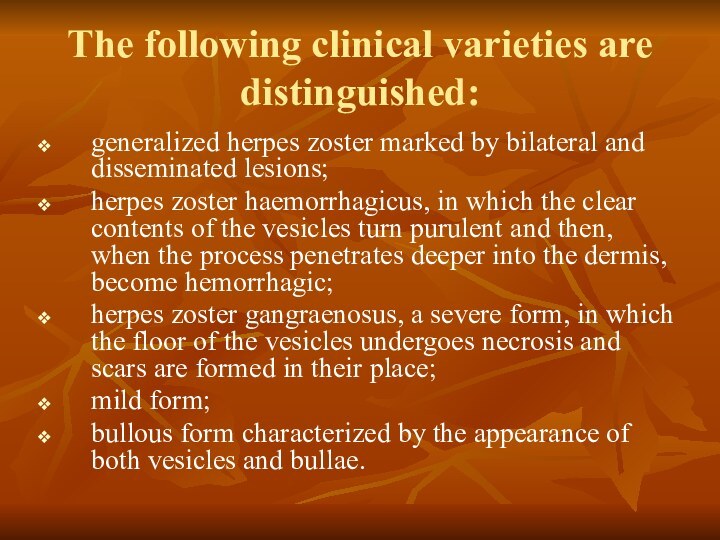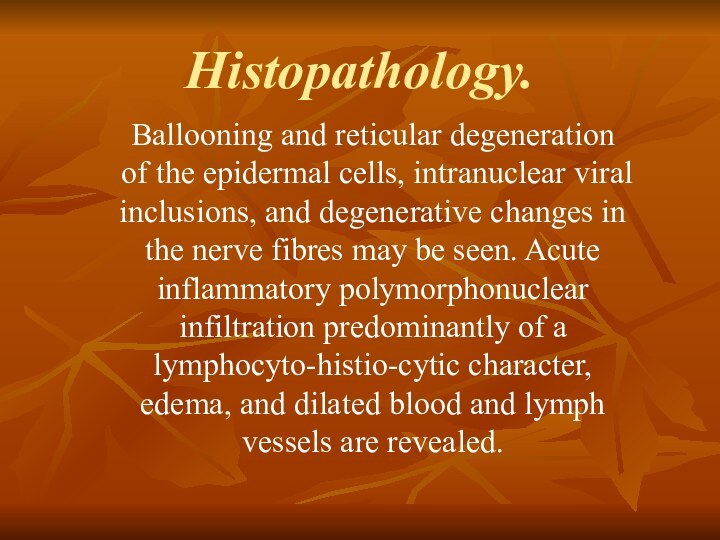- Главная
- Разное
- Бизнес и предпринимательство
- Образование
- Развлечения
- Государство
- Спорт
- Графика
- Культурология
- Еда и кулинария
- Лингвистика
- Религиоведение
- Черчение
- Физкультура
- ИЗО
- Психология
- Социология
- Английский язык
- Астрономия
- Алгебра
- Биология
- География
- Геометрия
- Детские презентации
- Информатика
- История
- Литература
- Маркетинг
- Математика
- Медицина
- Менеджмент
- Музыка
- МХК
- Немецкий язык
- ОБЖ
- Обществознание
- Окружающий мир
- Педагогика
- Русский язык
- Технология
- Физика
- Философия
- Химия
- Шаблоны, картинки для презентаций
- Экология
- Экономика
- Юриспруденция
Что такое findslide.org?
FindSlide.org - это сайт презентаций, докладов, шаблонов в формате PowerPoint.
Обратная связь
Email: Нажмите что бы посмотреть
Презентация на тему Bullous and vesicular dermatoses
Содержание
- 2. Theoretical partThe group of vesicular and bullosus
- 3. True (acantholytic) pemphigusPemphigus is a malignant, serious
- 4. Etiology and pathogenesis of pemphigusThere are different
- 5. Clinical varieties Four forms of true pemphigus
- 6. Pemphigus Vulgaris This form of pemphigus accounts
- 7. Pemphigus VulgarisUsually dermatosis begins with affection of
- 8. Pemphigus Vegetans At the beginning of its
- 9. Pemphigus VegetansPapulomatous growths secreting a considerable amount
- 10. Pemphigus Foliaceus The disease is characterized by
- 11. Pemphigus seborrhoicus, or erythematosus (Senear-Usher syndrome)Pemphigus seborrhoicus
- 12. Pemphigus seborrhoicus, or erythematosusThe lesions usually first
- 13. Diagnosis and differential diagnosisDifferential diagnosis is carried
- 14. Dermatitis herpetiformis (Duhring’s disease)
- 15. Herpes simplex The disease is caused by
- 16. TreatmentTreatment with steroid hormones envisages the prescription
- 17. Treatment. Drying and disinfectant agents are used
- 18. The following clinical forms are distinguished: mild;
- 19. Histopathology The characteristic findings are ballooning and,
- 20. Herpes zoster Herpes zoster, also called shingles
- 21. The following clinical varieties are distinguished: generalized
- 22. Histopathology. Ballooning and reticular degeneration of the
- 23. Скачать презентацию
- 24. Похожие презентации
Theoretical partThe group of vesicular and bullosus dermatoses includes different diseases on the basis of etiology and pathogenesis (pemphigus, Duhring’s dermatosis, simple vesicular lichens, herpes zoster, exudative multimorphic erythema).























Слайд 3
True (acantholytic) pemphigus
Pemphigus is a malignant, serious disease.
Its clinical manifestation is the formation of vesicles on
non-inflamed skin and mucous membranes. If not treated the bulloses soon appear on the whole skin. Patients should consult not only dermatologists but also other specialists (physicians, dentists, infectionists). Due to this, the knowledge of this pathology is necessary for all the clinicians to render qualified help to the patients.
Слайд 4
Etiology and pathogenesis of pemphigus
There are different etiopathogenic
theories, in particular, the viral theory but it is
not completely proved. Recently autoimmune processes are considered to be of great importance in the pathogenesis: discovery of antibodies to intercellular substance in the skin, in liquid of the bulloses and in blood serum. In immunofluorescence, in intercellular space of stratum spinosum of epidermis immunoglobulin G is found only in the patients with pemphigus.
Слайд 5
Clinical varieties
Four forms of true pemphigus are
differentiated:
pemphigus vulgaris (common) pemphigus vegetans
pemphigus foliaceus (exfoliative)
seborrheal pemphigus
Слайд 6
Pemphigus Vulgaris
This form of pemphigus accounts for approximately
75 per cent of the total number of all
forms of pemphigus
Слайд 7
Pemphigus Vulgaris
Usually dermatosis begins with affection of the
oral and throat mucosa, after which, as a rule,
the skin of the trunk, limbs, inguinal region, axillae, face and external genitals is involved in the process.
Слайд 8
Pemphigus Vegetans
At the beginning of its development this
form of pemphigus is clinically similar to pemphigus vulgaris
and often starts with the appearance of lesions on the oral mucosa. From the very onset of the disease, however, attention is drawn to the tendency of the bullae to be localized around the natural orifices, the navel and in the region of the large skin folds
Слайд 9
Pemphigus Vegetans
Papulomatous growths secreting a considerable amount of
exudate are formed later in places of the ruptured
bullae against the background of an eroded surface covered with a dirty film. The lesions tend to coalesce and form large vegetative surfaces at places with purulent necrotic disintegration. Nikolsky's sign is often positive. The dermatosis is accompanied with pain and a sensation of burning. Active movements are difficult because of sharp pain
Слайд 10
Pemphigus Foliaceus
The disease is characterized by drastic acantholysis
leading to the formation of superficial fissures directly under
the horny layer, which later turn into bullae.At the beginning of the disease, flaccid bullae with a thin top and slightly elevated above the surface form on apparently healthy skin. They rupture rapidly with the formation of large erosions. More frequently the tops of the bullae dry up into thin stratified scaly crusts. Epithelization of erosions under the crusts is slow. New portions of the exudate cause the layering of these crusts, producing a scaly surface, hence there is a term 'exfoliative', by which the disease is also known. It is in this variant of pemphigus that the sign described by Nikolsky in 1896 is always sharply positive.
Слайд 11
Pemphigus seborrhoicus,
or erythematosus (Senear-Usher syndrome)
Pemphigus seborrhoicus belongs to
the group of true pemphigus because the possibility of
its development into the foliaceus or vulgaris variant has been authentically proved.
Слайд 12
Pemphigus seborrhoicus,
or erythematosus
The lesions usually first appear on
the face and less frequently on the scalp, chest
and back. Closely arranged greasy crusts are formed against an erythematous background and simulate the picture of cicatrizing erythematosis on the face. Moist eroded surfaces are exposed when the crusts are removed. Acantholytic cells are seen in impression smears from these surfaces. The bullae are often formed unnoticeably and the crusts seem to be primary lesions. In other cases vesicles covered with stratified yellowish crusts are formed on the trunk and limbs, in sites characteristic of seborrhea. Lesions rarely occur on the mucous membranes, but if this happens, they are a bad prognostic sign.
Слайд 13
Diagnosis and differential diagnosis
Differential diagnosis is carried out
with multiform exudative erythema, bullous toxicoderma (Lyell’s syndrome) and
Duhring’s dermatosis
Слайд 15
Herpes simplex
The disease is caused by a filtrable
virus and is characterized by eruption of grouped vesicles
filled with a clear and then thick content, on a hyperemic area. The primary sites are the lips (herpes labialis), cheeks (herpes facialis), the wings of the nose (herpes nasalis), oral mucosa (herpes buccalis), cornea (herpes corneae), and genitals (herpes genitalis).
Слайд 16
Treatment
Treatment with steroid hormones envisages the prescription of
maximum doses (80-100 mg of prednisolone or methylprednisolone, 4‑6 mg
of dexamethasone daily). When new eruptions cease to appear and exudative phenomena in the foci diminishes, the dose of corticosteroids may be reduced, but very slowly (to avoid exacerbation of the process and prevent the 'phenomenon of steroid drug discontinuation').
Слайд 17
Treatment.
Drying and disinfectant agents are used externally:
lotions of Aq. Goulardi and 1-4 per cent silver
nitrate solution, 1-2 per cent pyoktanin (gentian violet) solution, 1-2-3 per cent oxolinum or 30-50 per cent interferon ointment, Bonaphton, gossypol, tebrophenum, 1-3 per cent Florenal ointment, and sulfur-carbolic paste (Ac. carbolici 1.0, Sulfuris 1.5, Pastae Zinci 30.0).
Слайд 18
The following clinical forms are distinguished:
mild; with
rapid resolution of the few lesions that have erupted;
edematous; accompanied with bright hyperemia and marked swelling;
severe;
zosteriform;
frequently recurring; localized on the lips, buttocks, and external genitals.
Слайд 19
Histopathology
The characteristic findings are ballooning and, to
a lesser extent, reticular degeneration of the epidermal cells
and acantholysis. There are intranuclear eosinophilic inclusions in the ballooning cells and dilated blood vessels, edema, and mild perivascular infiltration in the dermal papillary layer.
Слайд 20
Herpes zoster
Herpes zoster, also called shingles or zona,
is caused by a neurotropic filtrable virus Strongiloplasma zonae
which resembles or is identical with the chickenpox virus in antigenic structure and the ability to grow in human embryonic tissues
Слайд 21
The following clinical varieties are distinguished:
generalized herpes
zoster marked by bilateral and disseminated lesions;
herpes zoster
haemorrhagicus, in which the clear contents of the vesicles turn purulent and then, when the process penetrates deeper into the dermis, become hemorrhagic; herpes zoster gangraenosus, a severe form, in which the floor of the vesicles undergoes necrosis and scars are formed in their place;
mild form;
bullous form characterized by the appearance of both vesicles and bullae.





























